Abstract
Six recombinant human Fab fragments that were derived from the same human immunodeficiency virus type 1 (HIV-1)-infected individual and are directed against the CD4 binding site (CD4bs) of the gp120 envelope glycoprotein were studied. A range of neutralizing activity against the HIV-1 (HXBc2) isolate was observed, with Fab b12 exhibiting the greatest potency among the Fabs tested. The neutralizing potency of Fab b12 was better than that of monoclonal whole antibodies directed against the third variable (V3) region of gp120. To explore the basis for the efficient neutralizing activity of b12, the recognition of a panel of HIV-1 gp120 mutants by the six Fabs was studied. The patterns of sensitivity to particular gp120 amino acid changes were similar for all six Fabs to those seen for anti-CD4bs monoclonal antibodies derived from HIV-1-infected individuals by conventional means. In addition, recognition by Fab b12 demonstrated an atypical sensitivity to changes in the V1 and V2 variable regions. Next, the binding of the Fabs to monomeric gp120 and to the envelope glycoprotein complex was examined. Neither the binding properties of the b12 Fab to monomeric gp120 nor the ability of the Fab to compete with soluble CD4 for monomeric gp120 binding appeared to account for the greater neutralizing potency. However, both quantitative and qualitative differences between the binding of b12 and that of less potent Fabs to the cell surface envelope glycoprotein complex were observed. Relative to less potently neutralizing Fabs, Fab b12 exhibited a higher affinity for a subpopulation of cell surface envelope glycoproteins, the conformation of which was best approximated by the mature gp120 glycoprotein. Apparently, subtle differences in the gp120 epitope recognized allow some members of the group of anti-CD4bs antibodies to bind to the functionally relevant envelope glycoprotein complex and to neutralize virus more efficiently.
Full text
PDF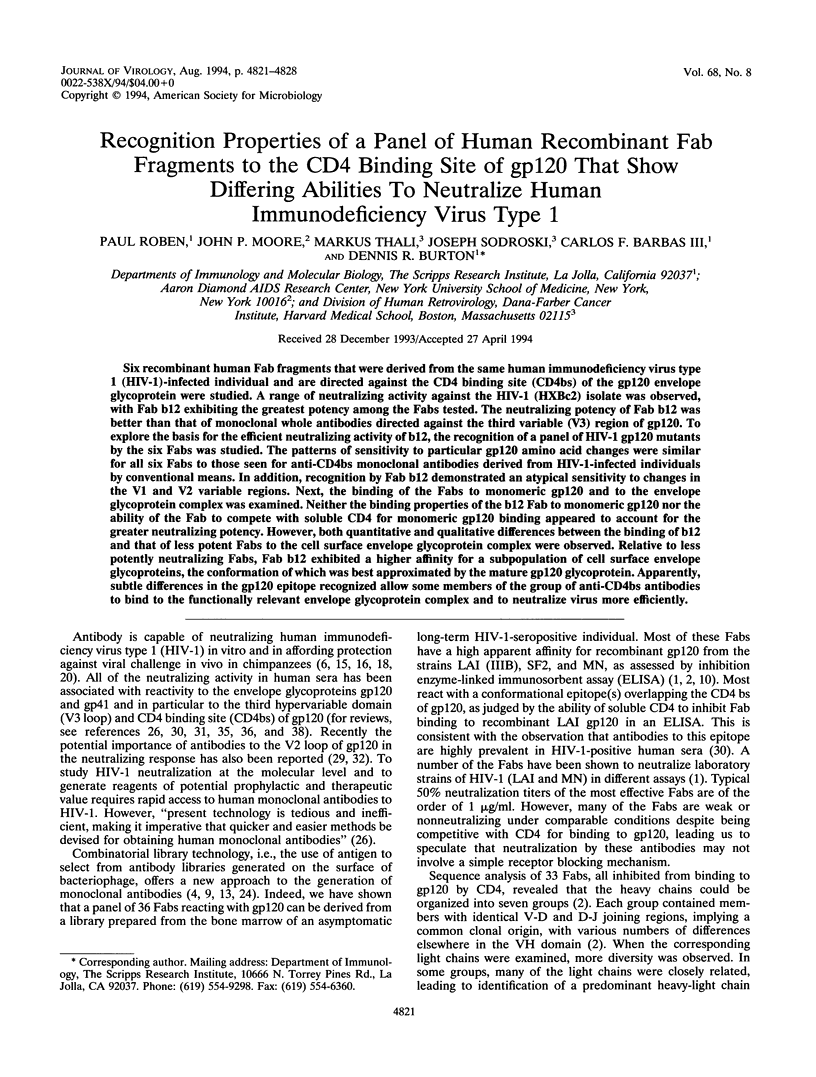
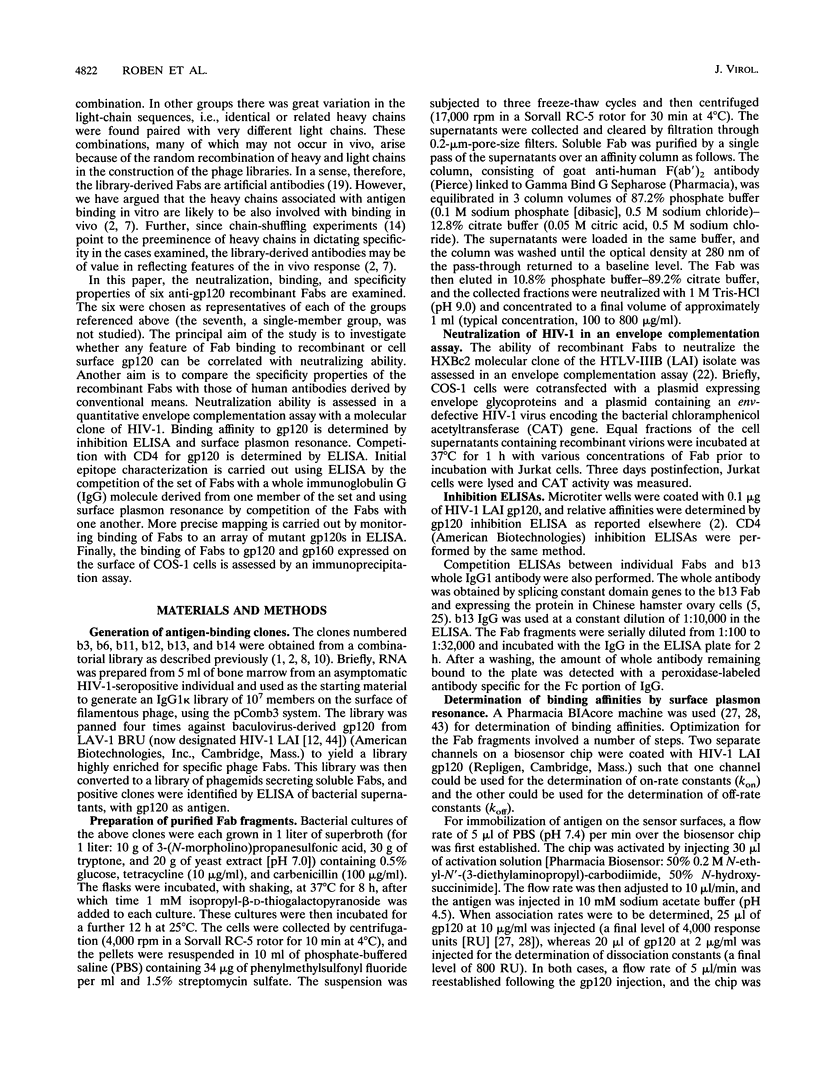
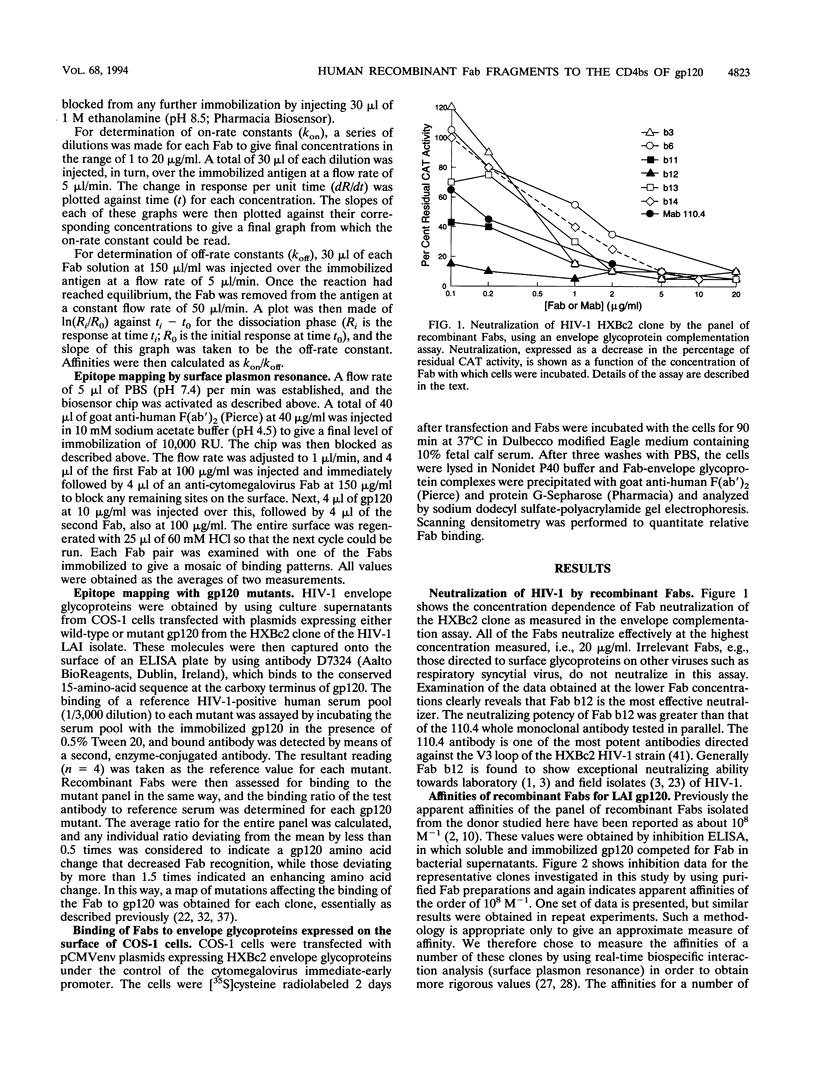
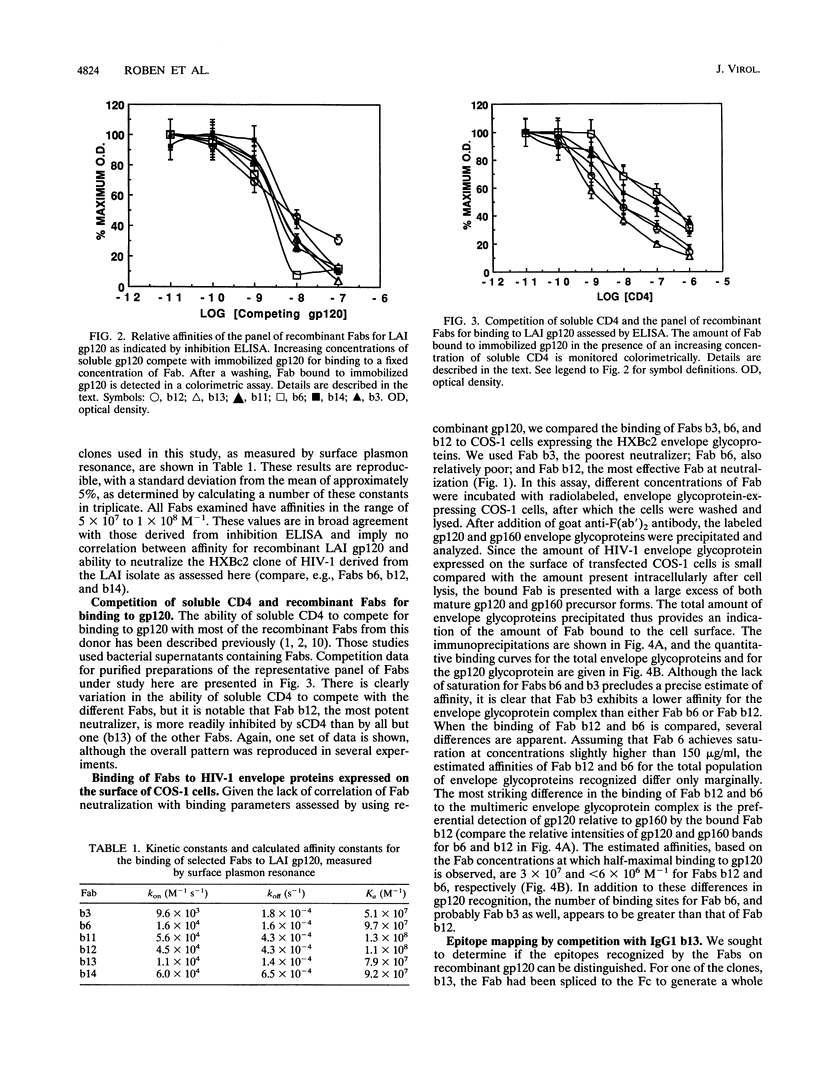
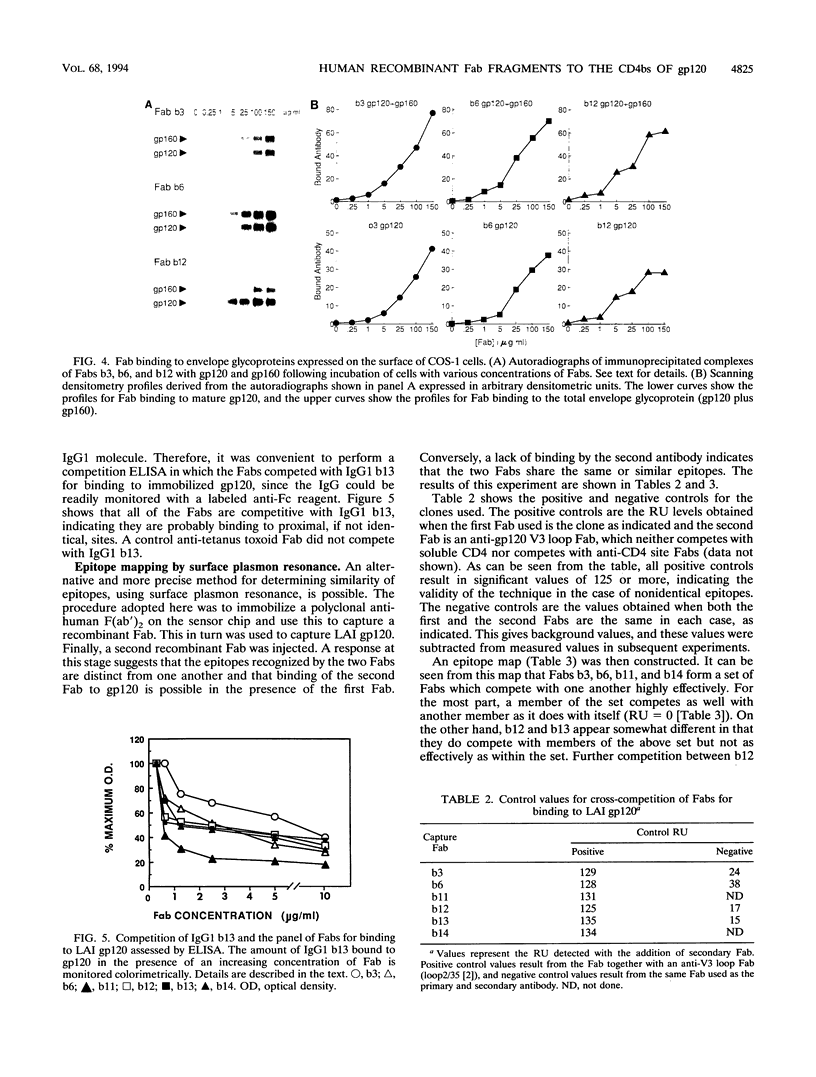
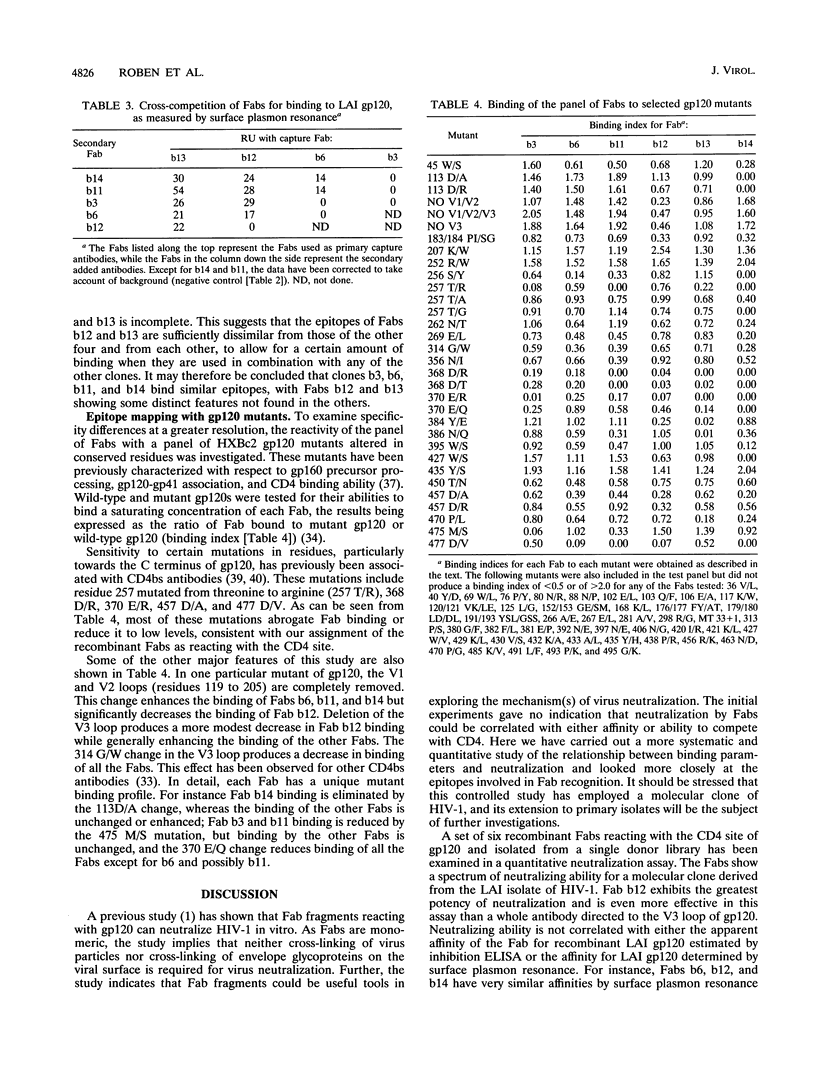
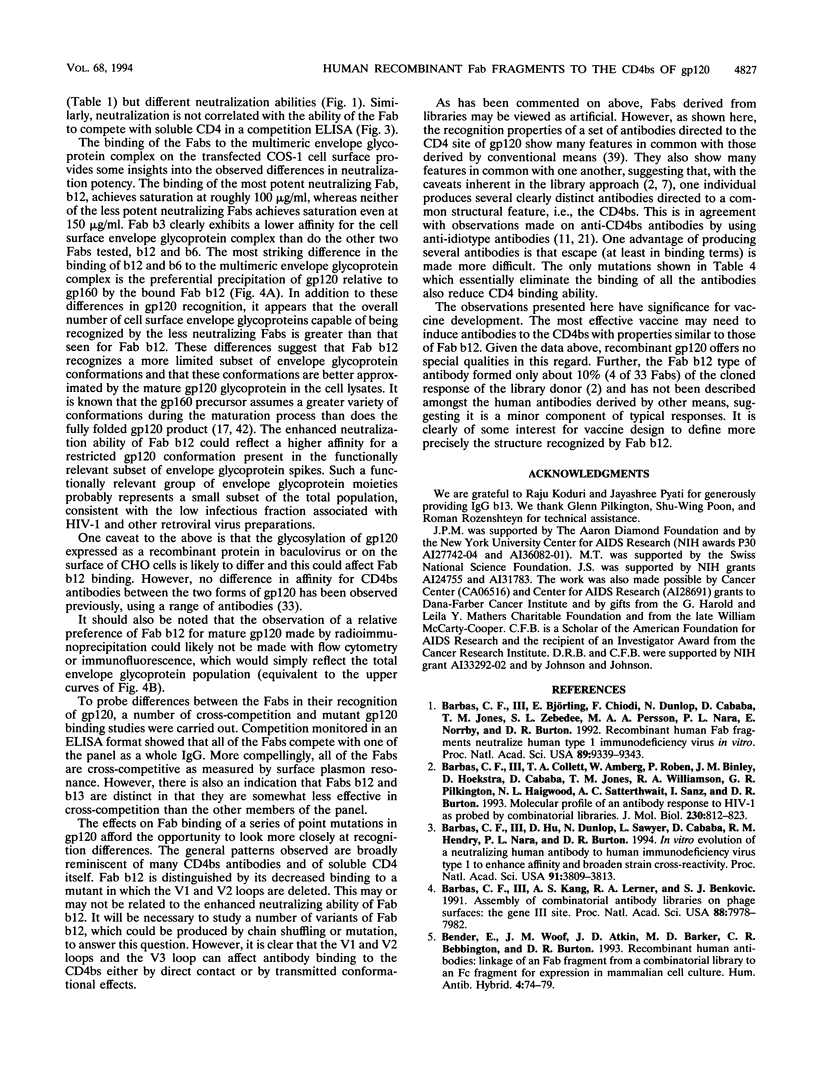
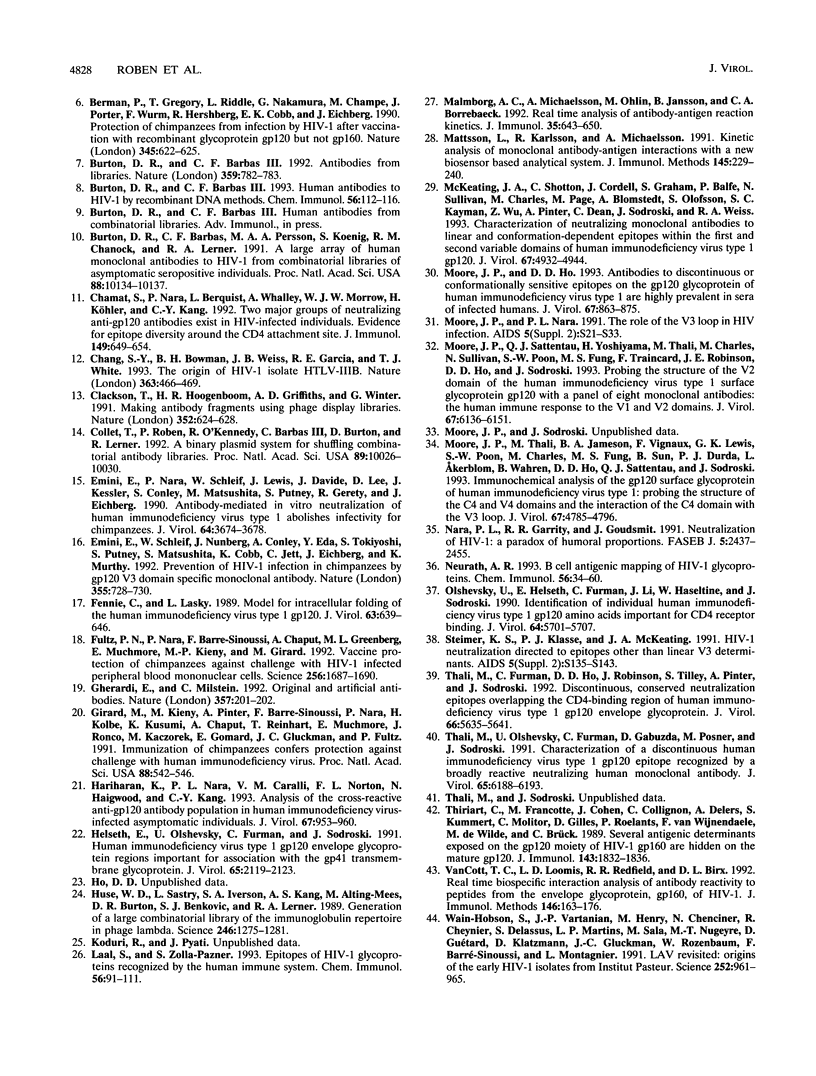
Images in this article
Selected References
These references are in PubMed. This may not be the complete list of references from this article.
- Barbas C. F., 3rd, Björling E., Chiodi F., Dunlop N., Cababa D., Jones T. M., Zebedee S. L., Persson M. A., Nara P. L., Norrby E. Recombinant human Fab fragments neutralize human type 1 immunodeficiency virus in vitro. Proc Natl Acad Sci U S A. 1992 Oct 1;89(19):9339–9343. doi: 10.1073/pnas.89.19.9339. [DOI] [PMC free article] [PubMed] [Google Scholar]
- Barbas C. F., 3rd, Collet T. A., Amberg W., Roben P., Binley J. M., Hoekstra D., Cababa D., Jones T. M., Williamson R. A., Pilkington G. R. Molecular profile of an antibody response to HIV-1 as probed by combinatorial libraries. J Mol Biol. 1993 Apr 5;230(3):812–823. doi: 10.1006/jmbi.1993.1203. [DOI] [PubMed] [Google Scholar]
- Barbas C. F., 3rd, Hu D., Dunlop N., Sawyer L., Cababa D., Hendry R. M., Nara P. L., Burton D. R. In vitro evolution of a neutralizing human antibody to human immunodeficiency virus type 1 to enhance affinity and broaden strain cross-reactivity. Proc Natl Acad Sci U S A. 1994 Apr 26;91(9):3809–3813. doi: 10.1073/pnas.91.9.3809. [DOI] [PMC free article] [PubMed] [Google Scholar]
- Barbas C. F., 3rd, Kang A. S., Lerner R. A., Benkovic S. J. Assembly of combinatorial antibody libraries on phage surfaces: the gene III site. Proc Natl Acad Sci U S A. 1991 Sep 15;88(18):7978–7982. doi: 10.1073/pnas.88.18.7978. [DOI] [PMC free article] [PubMed] [Google Scholar]
- Bender E., Woof J. M., Atkin J. D., Barker M. D., Bebbington C. R., Burton D. R. Recombinant human antibodies: linkage of an Fab fragment from a combinatorial library to an Fc fragment for expression in mammalian cell culture. Hum Antibodies Hybridomas. 1993 Apr;4(2):74–79. [PubMed] [Google Scholar]
- Berman P. W., Gregory T. J., Riddle L., Nakamura G. R., Champe M. A., Porter J. P., Wurm F. M., Hershberg R. D., Cobb E. K., Eichberg J. W. Protection of chimpanzees from infection by HIV-1 after vaccination with recombinant glycoprotein gp120 but not gp160. Nature. 1990 Jun 14;345(6276):622–625. doi: 10.1038/345622a0. [DOI] [PubMed] [Google Scholar]
- Burton D. R., Barbas C. F., 3rd Antibodies from libraries. Nature. 1992 Oct 29;359(6398):782–783. doi: 10.1038/359782b0. [DOI] [PubMed] [Google Scholar]
- Burton D. R., Barbas C. F., 3rd Human antibodies to HIV-1 by recombinant DNA methods. Chem Immunol. 1993;56:112–126. [PubMed] [Google Scholar]
- Burton D. R., Barbas C. F., 3rd, Persson M. A., Koenig S., Chanock R. M., Lerner R. A. A large array of human monoclonal antibodies to type 1 human immunodeficiency virus from combinatorial libraries of asymptomatic seropositive individuals. Proc Natl Acad Sci U S A. 1991 Nov 15;88(22):10134–10137. doi: 10.1073/pnas.88.22.10134. [DOI] [PMC free article] [PubMed] [Google Scholar]
- Chamat S., Nara P., Berquist L., Whalley A., Morrow W. J., Köhler H., Kang C. Y. Two major groups of neutralizing anti-gp120 antibodies exist in HIV-infected individuals. Evidence for epitope diversity around the CD4 attachment site. J Immunol. 1992 Jul 15;149(2):649–654. [PubMed] [Google Scholar]
- Chang S. Y., Bowman B. H., Weiss J. B., Garcia R. E., White T. J. The origin of HIV-1 isolate HTLV-IIIB. Nature. 1993 Jun 3;363(6428):466–469. doi: 10.1038/363466a0. [DOI] [PubMed] [Google Scholar]
- Clackson T., Hoogenboom H. R., Griffiths A. D., Winter G. Making antibody fragments using phage display libraries. Nature. 1991 Aug 15;352(6336):624–628. doi: 10.1038/352624a0. [DOI] [PubMed] [Google Scholar]
- Collet T. A., Roben P., O'Kennedy R., Barbas C. F., 3rd, Burton D. R., Lerner R. A. A binary plasmid system for shuffling combinatorial antibody libraries. Proc Natl Acad Sci U S A. 1992 Nov 1;89(21):10026–10030. doi: 10.1073/pnas.89.21.10026. [DOI] [PMC free article] [PubMed] [Google Scholar]
- Emini E. A., Nara P. L., Schleif W. A., Lewis J. A., Davide J. P., Lee D. R., Kessler J., Conley S., Matsushita S., Putney S. D. Antibody-mediated in vitro neutralization of human immunodeficiency virus type 1 abolishes infectivity for chimpanzees. J Virol. 1990 Aug;64(8):3674–3678. doi: 10.1128/jvi.64.8.3674-3678.1990. [DOI] [PMC free article] [PubMed] [Google Scholar]
- Emini E. A., Schleif W. A., Nunberg J. H., Conley A. J., Eda Y., Tokiyoshi S., Putney S. D., Matsushita S., Cobb K. E., Jett C. M. Prevention of HIV-1 infection in chimpanzees by gp120 V3 domain-specific monoclonal antibody. Nature. 1992 Feb 20;355(6362):728–730. doi: 10.1038/355728a0. [DOI] [PubMed] [Google Scholar]
- Fennie C., Lasky L. A. Model for intracellular folding of the human immunodeficiency virus type 1 gp120. J Virol. 1989 Feb;63(2):639–646. doi: 10.1128/jvi.63.2.639-646.1989. [DOI] [PMC free article] [PubMed] [Google Scholar]
- Fultz P. N., Nara P., Barre-Sinoussi F., Chaput A., Greenberg M. L., Muchmore E., Kieny M. P., Girard M. Vaccine protection of chimpanzees against challenge with HIV-1-infected peripheral blood mononuclear cells. Science. 1992 Jun 19;256(5064):1687–1690. doi: 10.1126/science.256.5064.1687. [DOI] [PubMed] [Google Scholar]
- Gherardi E., Milstein C. Original and artificial antibodies. Nature. 1992 May 21;357(6375):201–202. doi: 10.1038/357201a0. [DOI] [PubMed] [Google Scholar]
- Girard M., Kieny M. P., Pinter A., Barre-Sinoussi F., Nara P., Kolbe H., Kusumi K., Chaput A., Reinhart T., Muchmore E. Immunization of chimpanzees confers protection against challenge with human immunodeficiency virus. Proc Natl Acad Sci U S A. 1991 Jan 15;88(2):542–546. doi: 10.1073/pnas.88.2.542. [DOI] [PMC free article] [PubMed] [Google Scholar]
- Hariharan K., Nara P. L., Caralli V. M., Norton F. L., Haigwood N., Kang C. Y. Analysis of the cross-reactive anti-gp120 antibody population in human immunodeficiency virus-infected asymptomatic individuals. J Virol. 1993 Feb;67(2):953–960. doi: 10.1128/jvi.67.2.953-960.1993. [DOI] [PMC free article] [PubMed] [Google Scholar]
- Helseth E., Olshevsky U., Furman C., Sodroski J. Human immunodeficiency virus type 1 gp120 envelope glycoprotein regions important for association with the gp41 transmembrane glycoprotein. J Virol. 1991 Apr;65(4):2119–2123. doi: 10.1128/jvi.65.4.2119-2123.1991. [DOI] [PMC free article] [PubMed] [Google Scholar]
- Huse W. D., Sastry L., Iverson S. A., Kang A. S., Alting-Mees M., Burton D. R., Benkovic S. J., Lerner R. A. Generation of a large combinatorial library of the immunoglobulin repertoire in phage lambda. Science. 1989 Dec 8;246(4935):1275–1281. doi: 10.1126/science.2531466. [DOI] [PubMed] [Google Scholar]
- Karlsson R., Michaelsson A., Mattsson L. Kinetic analysis of monoclonal antibody-antigen interactions with a new biosensor based analytical system. J Immunol Methods. 1991 Dec 15;145(1-2):229–240. doi: 10.1016/0022-1759(91)90331-9. [DOI] [PubMed] [Google Scholar]
- Laal S., Zolla-Pazner S. Epitopes of HIV-1 glycoproteins recognized by the human immune system. Chem Immunol. 1993;56:91–111. [PubMed] [Google Scholar]
- Malmborg A. C., Michaëlsson A., Ohlin M., Jansson B., Borrebaeck C. A. Real time analysis of antibody-antigen reaction kinetics. Scand J Immunol. 1992 Jun;35(6):643–650. doi: 10.1111/j.1365-3083.1992.tb02970.x. [DOI] [PubMed] [Google Scholar]
- McKeating J. A., Shotton C., Cordell J., Graham S., Balfe P., Sullivan N., Charles M., Page M., Bolmstedt A., Olofsson S. Characterization of neutralizing monoclonal antibodies to linear and conformation-dependent epitopes within the first and second variable domains of human immunodeficiency virus type 1 gp120. J Virol. 1993 Aug;67(8):4932–4944. doi: 10.1128/jvi.67.8.4932-4944.1993. [DOI] [PMC free article] [PubMed] [Google Scholar]
- Moore J. P., Ho D. D. Antibodies to discontinuous or conformationally sensitive epitopes on the gp120 glycoprotein of human immunodeficiency virus type 1 are highly prevalent in sera of infected humans. J Virol. 1993 Feb;67(2):863–875. doi: 10.1128/jvi.67.2.863-875.1993. [DOI] [PMC free article] [PubMed] [Google Scholar]
- Moore J. P., Nara P. L. The role of the V3 loop of gp120 in HIV infection. AIDS. 1991;5 (Suppl 2):S21–S33. doi: 10.1097/00002030-199101001-00004. [DOI] [PubMed] [Google Scholar]
- Moore J. P., Sattentau Q. J., Yoshiyama H., Thali M., Charles M., Sullivan N., Poon S. W., Fung M. S., Traincard F., Pinkus M. Probing the structure of the V2 domain of human immunodeficiency virus type 1 surface glycoprotein gp120 with a panel of eight monoclonal antibodies: human immune response to the V1 and V2 domains. J Virol. 1993 Oct;67(10):6136–6151. doi: 10.1128/jvi.67.10.6136-6151.1993. [DOI] [PMC free article] [PubMed] [Google Scholar]
- Moore J. P., Thali M., Jameson B. A., Vignaux F., Lewis G. K., Poon S. W., Charles M., Fung M. S., Sun B., Durda P. J. Immunochemical analysis of the gp120 surface glycoprotein of human immunodeficiency virus type 1: probing the structure of the C4 and V4 domains and the interaction of the C4 domain with the V3 loop. J Virol. 1993 Aug;67(8):4785–4796. doi: 10.1128/jvi.67.8.4785-4796.1993. [DOI] [PMC free article] [PubMed] [Google Scholar]
- Nara P. L., Garrity R. R., Goudsmit J. Neutralization of HIV-1: a paradox of humoral proportions. FASEB J. 1991 Jul;5(10):2437–2455. doi: 10.1096/fasebj.5.10.1712328. [DOI] [PubMed] [Google Scholar]
- Neurath A. R. B cell antigenic site mapping of HIV-1 glycoproteins. Chem Immunol. 1993;56:34–60. [PubMed] [Google Scholar]
- Olshevsky U., Helseth E., Furman C., Li J., Haseltine W., Sodroski J. Identification of individual human immunodeficiency virus type 1 gp120 amino acids important for CD4 receptor binding. J Virol. 1990 Dec;64(12):5701–5707. doi: 10.1128/jvi.64.12.5701-5707.1990. [DOI] [PMC free article] [PubMed] [Google Scholar]
- Steimer K. S., Klasse P. J., McKeating J. A. HIV-1 neutralization directed to epitopes other than linear V3 determinants. AIDS. 1991;5 (Suppl 2):S135–S143. doi: 10.1097/00002030-199101001-00019. [DOI] [PubMed] [Google Scholar]
- Thali M., Furman C., Ho D. D., Robinson J., Tilley S., Pinter A., Sodroski J. Discontinuous, conserved neutralization epitopes overlapping the CD4-binding region of human immunodeficiency virus type 1 gp120 envelope glycoprotein. J Virol. 1992 Sep;66(9):5635–5641. doi: 10.1128/jvi.66.9.5635-5641.1992. [DOI] [PMC free article] [PubMed] [Google Scholar]
- Thali M., Olshevsky U., Furman C., Gabuzda D., Posner M., Sodroski J. Characterization of a discontinuous human immunodeficiency virus type 1 gp120 epitope recognized by a broadly reactive neutralizing human monoclonal antibody. J Virol. 1991 Nov;65(11):6188–6193. doi: 10.1128/jvi.65.11.6188-6193.1991. [DOI] [PMC free article] [PubMed] [Google Scholar]
- Thiriart C., Francotte M., Cohen J., Collignon C., Delers A., Kummert S., Molitor C., Gilles D., Roelants P., van Wijnendaele F. Several antigenic determinants exposed on the gp120 moiety of HIV-1 gp160 are hidden on the mature gp120. J Immunol. 1989 Sep 15;143(6):1832–1836. [PubMed] [Google Scholar]
- VanCott T. C., Loomis L. D., Redfield R. R., Birx D. L. Real-time biospecific interaction analysis of antibody reactivity to peptides from the envelope glycoprotein, gp160, of HIV-1. J Immunol Methods. 1992 Feb 5;146(2):163–176. doi: 10.1016/0022-1759(92)90225-i. [DOI] [PubMed] [Google Scholar]
- Wain-Hobson S., Vartanian J. P., Henry M., Chenciner N., Cheynier R., Delassus S., Martins L. P., Sala M., Nugeyre M. T., Guétard D. LAV revisited: origins of the early HIV-1 isolates from Institut Pasteur. Science. 1991 May 17;252(5008):961–965. doi: 10.1126/science.2035026. [DOI] [PubMed] [Google Scholar]



